Is Redheaded Flea Beetle Really That Big of a Deal?
Let me first gripe about the second half of this question.
Years ago, part of my job as a young assistant professor was to write proposals and get grant money so that I could research certain pest biology or pest management issues. I wrote a grant to support a project to study the biology and management of bermudagrass mite. One day, I received a phone call from someone on the proposal review panel and was faced with the question of, “I’ve never seen this pest before, so is it really a big deal?”
Perhaps I didn’t or couldn’t express the importance and urgency of the research sufficiently, but when some ideas you thought were important, but were challenged by someone who didn’t understand the issues, that could leave a bad taste in your mouth, rightly or wrongly. Obviously, I’m still kind of cross about it 10 years later. I never say I’m a man with a big heart—more like a kid who didn't get what he wanted.
So let me be clear: Redheaded flea beetle (RHFB) isn’t the boogieman appearing only in presentations at Cultivate or articles in GrowerTalks. It’s a real, big deal for folks who are dealing with it.
The answer is a firm “yes” from many growers of containerized ornamental plants in the Mid-Atlantic and the South. I’m hearing more complaints about this pest from folks in New England, around the Great Lakes and on the Plains. Panicled hydrangea, rose, Virginia sweetspire, azalea, holly and weigela are the most attacked hosts, but the list of suitable host plants is 50-plus species long. It’s also an important pest of cranberry in Wisconsin.
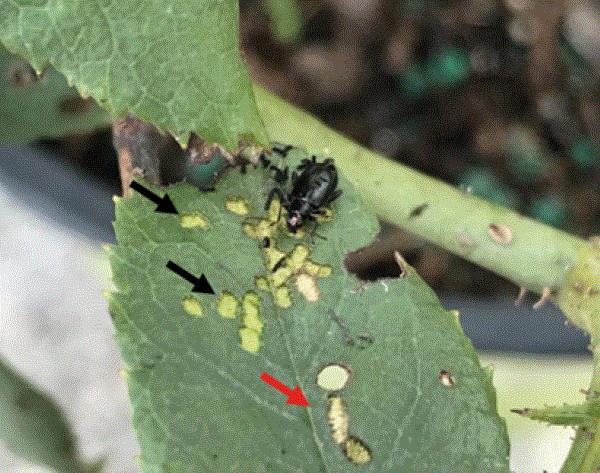
A redheaded flea beetle adult and its damage on a rose leaf. (Photo credit: Shimat Joseph, University of Georgia.)
Adult redheaded flea beetles create shotholes or skeletonize the leaves. Growers often spray weekly, as soon as foliar damage appears, to prevent damage. According to a survey of growers, the most commonly used insecticides are neonicotinoids, carbaryl, pyrethroids, organophosphates and diamide insecticides. The management cost averaged $663 per acre per year. Even intensive management may not achieve the desirable outcomes. Most affected growers manage the pest on a yearly basis.
I’ve been lucky enough to collaborate with Shimat Joseph of the University of Georgia and Alejandro Del Pozo-Valdivia of Virginia Tech in several research projects in the past few years. Along with other colleagues, we’ve published summaries of the economic impact and the biology and management of RHFB. These summaries already need to be updated with recent research findings.
I want to summarize some of the most recent of those research findings in today’s newsletter. I hope the information will be useful to you in dealing with the RHFB.

When are RHFB Active?
Both adult and immature RHFB feed on plants—adults feed on the foliage and larvae feed on the roots. Feeding by adults causes shotholes and skeletonization. The feeding damage by larvae, which may include stunted growth or other root-related issues, is harder and poorly quantified.
Growers often scout for adults because their presence and damage are so obvious. The red heads and shiny blue-black bodies make the adults quite distinctive. (Some populations have darker or brown heads.) They feed, mate, and jump and fly around the canopy in the morning. They become less active once the sun is high in the sky. (I often don’t see the adults in the afternoon, but a recent study reported that the adults are most active from 11:00 a.m. to 3:00 p.m. in eastern Virginia.)
Most growers report foliar damage from April to October. There may be three generations in the Southeast based on adult activity. Adults of the first generation (the generation resulting from the overwintering eggs) appear relatively consistent in May in Georgia and the Carolinas, but the next two generations are overlapping, which result in adults being present throughout the summer and fall. Adult abundance peaks in June, late July and late August to early September in eastern Virginia. Fewer generations and a shorter activity period are seen in the northern states.
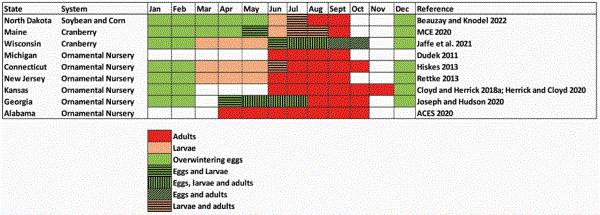
Activity period of redheaded flea beetle life stages. (Source: Arshad et al. 2023; Journal of Integrated Pest Management.)
Brian Kunkel of the University of Delaware and Danny Lauderdale of North Carolina State University have determined the degree-days (DD; base temperature of 50F and start date of January 1) when adults and larvae are active. The first-generation larvae hatch from the overwintering eggs between 242 and 370 DD in the Mid-Atlantic and between 250 and 480 DD in North Carolina. The hatching corresponds with full bloom of black locusts in the Mid-Atlantic. First-generation adults appear between 500 and 800 DD in North Carolina and around the time of southern magnolia bloom, and between 517 and 1028 DD or around the time of southern magnolia bud swell in the Mid-Atlantic.
Since the second (and possibly third) generations are overlapping, knowing the degree-days and plant phenological indicators for these generations may not be as important as they are for the first generation.

How to Monitor RHFB
Knowing the degree-days and plant phenological indicators of the first generation is important for timing the start of a scouting program. Like many pests, degree-days and plant phenological indicators can get you close to the start dates of pest activities. But you still need to scout to determine with some certainty if the pests are indeed present and active so that you don’t waste a spray or two.
Scouting for larval activities can be a pain because you’ll have to pull up a plant, break down and dig through the root ball, and determine the number and life stage of the larvae. Most folks simply look for adults and foliar damage caused by the adults, which are easier to see. This method isn't entirely reliable because first you want to treat to prevent damage, so finding damage and adults may already be too late. And, secondly, adults are pretty hard to see if you scout too late in the day.
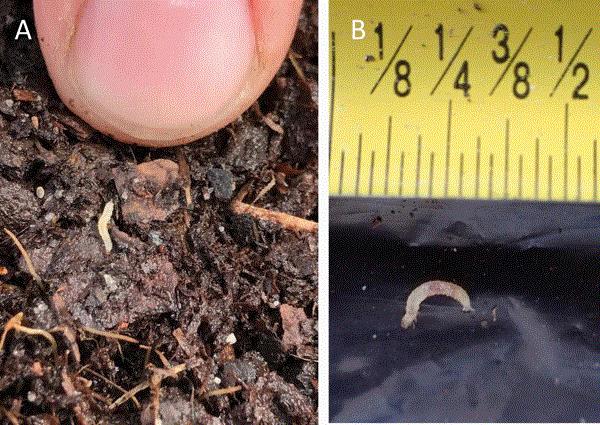
A redheaded flea beetle larva in potting media (A) and one next to a ruler to show size (B). (Photo credit: Danny Lauderdale, North Carolina State University.)
Despite the shortcomings, scouting for adults remains the predominant (if not the only) way of determining if treatment is needed. The suitability and reliability of other trapping methods (such as using pheromones, light or sticky cards) or monitoring methods (such as beat sheets or sweep nets) haven't been fully developed or tested. I evaluated the possibility of using sticky cards and beat sheet methods a few years ago and found them to be unsuccessful. Foliar damage always appeared weeks before I trapped or found the first adults on sticky cards or beat sheets.
Guess we could only rely on the method of observing adult damage. Since a treatment threshold for RHFB on ornamental plants hasn't been established and insecticide application is meant to prevent damage, scouting for adult damage should begin as soon as the accumulated degree-days reach the expected adult emergence (around 500 DD) and before damage appears.

How to Control Adults
While we don’t have a firmly established treatment threshold for RHFB, a recent study suggested that it’ll take a mere five adults to cause 4% defoliation on Limelight Hydrangea within a week. Because of the speed of damage, insecticide treatment must be applied as soon as adults are found or expected to prevent damage.
Adults are controlled by an insecticide applied during the morning (when adults are most active). Some growers may apply insecticides—usually every two weeks but at times weekly—when adults are present (May to October). High-volume spray is required to achieve good foliar coverage.
In addition to pyrethroids, carbaryl and organophosphates, adults have been effectively controlled with sprays of azadirachtin, neonicotinoids (acetamiprid, dinotefuran and thiamethoxam), sulfoxaflor + spinetoram, spinosad, tolfenpyrad and diamide insecticides (chlorantraniliprole, cyantraniliprole and cyclaniliprole).
A major complaint I've heard from growers is the poor residual longevity of the foliar-applied insecticides against adults, which often return with a vengeance in less than a week. The poor residual activity makes it necessary for growers to apply weekly when the beetles are abundant and active. I tried to solve this problem by mixing in surfactants of various kinds and formulations, which didn’t appear to help with increasing residual longevity.

The Importance of Controlling Larvae
Most growers target adults in their management programs, but is that the right approach? The fact that growers need to spray frequently to compensate for the short residual activity of insecticides hints at the unsustainability of the approach.
Let’s think differently. We've always assumed that adults are the target life stage of management because adults do the most observable damage and can come into nurseries from the surrounding fields in high numbers. Are these assumptions correct?
The first assumption is difficult to test and we don’t have any data to test that assumption currently. After all, larvae are hard to observe and their impact on roots (and subsequently the entire plant) is hard to quantify.
A couple of recent studies point out that the second assumption (adults are from fields surrounding the nursery) may not be correct.
A study in eastern Virginia didn’t find any adults in soybean fields (known as a host of RHFB) next to affected nurseries after 450 sweet-net samples. This suggests the assumption that adults invade nurseries from the surrounding fields doesn’t seem to hold up. So are the beetles coming from the nurseries?
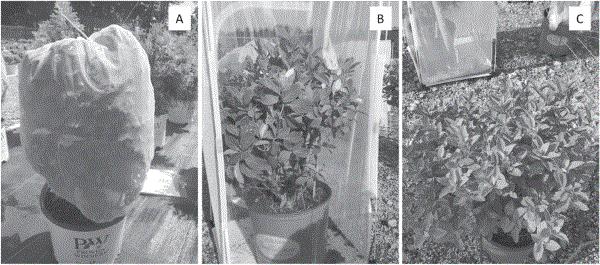
Panicled hydrangea plants were partially caged (only the canopy was caged; A), fully caged (both plant and pot were in the cage; B) or uncaged (C) in this study. (Photo credit: Arshad et al. 2023; Journal of Economic Entomology.)
The importance of within-nursery population is presented by another study conducted in Georgia, North Carolina and Virginia. (I’m a co-author of this paper.) In this study, we caged the entire panicled hydrangea plants (including pots), caged only the canopies and left the plants completely open (not caged). We observed the number and damage of the fully caged, partially caged and uncaged plants.
As expected, the plants with the canopies caged had few (if any) adults and didn’t suffer or only suffered minor feeding damage. The minor damage in these plants was usually caused by adults chewing on leaves through the cage screen. The fully caged and uncaged plants had similar numbers of adults and extent of damage, suggesting that adults coming from the potting media (which were prevented from leaving in the fully caged plants) were as abundant and as damaging as the plants that receive adults that were dispersing from other plants.
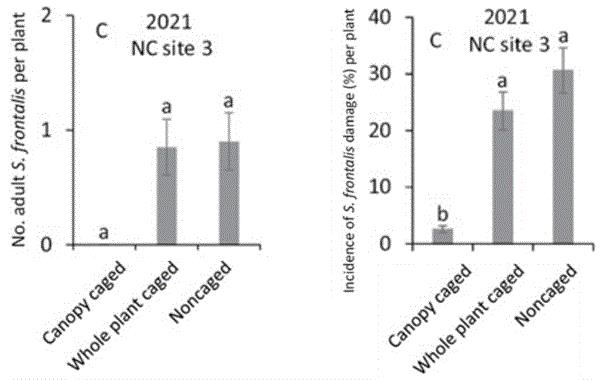
Caged study conducted by me at a containerized nursery in North Carolina suggested that adult redheaded flea beetles emerging from the pots were numerous and damaging. (Photo credit: Arshad et al. 2023; Journal of Economic Entomology.)
This study, although using a simple experimental design, demonstrates to me that the majority of adult RHFB likely results from the larval population in the nursery. This study also tells me that reducing the larval population in the pots is crucial to reducing the adult population and the foliar damage they can do.
It also suggests that y’all need to be careful with the rooted liners you receive. If these liners are infested, it’s likely that you’ll introduced RHFB into your operation. That will start an almost unending battle to control this pest.
Also, the studies didn’t negate the importance of good weed management. Although it’s not clear if larvae can build a population by feeding on the roots of weeds, I’ve seen with my own eyes adult RHFB feeding and sustaining a population on weeds (such as eclipta and pigweed) in nurseries, so clean those weeds up!

How to Control Larvae
I hope I’ve convinced y’all that you need to control the larvae in the pots, but what do you use to control larvae?
Danny Lauderdale conducted some of the first evaluations of management methods against RHFB larvae. He reported that drenching with azadirachtin, cyantraniliprole, dinotefuran, imidacloprid or thiamethoxam before 250 DD or between 250 and 500 DD can achieve significant reduction of larvae. Application of granular formulations of imidacloprid, either as a top-dressing or incorporation, also greatly reduces larval population.
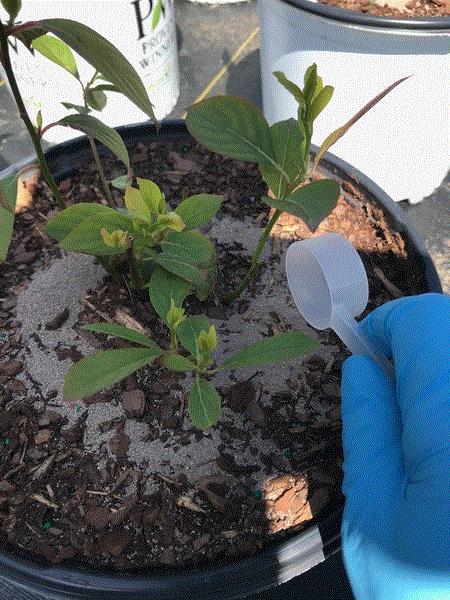
Top dressing with granular imidacloprid is effective against redheaded flea beetle larvae. (Photo credit: Danny Lauderdale, North Carolina State University.)
In a separate study, Shimat Joseph and Alejandro Del Pozo-Valdivia evaluated the efficacy of non-neonicotinoid insecticides against RHFB larvae. They tested nine active ingredients in four separate field experiments in Georgia and Virginia, and found that pots drenched with dinotefuran, cyclaniliprole, chloratraniliprole, tetraniliprole and spinetoram + sulfoxaflor were effective in reducing the numbers of adults emerged from the treated pots and the damage on the treated plants. Unfortunately, cyclaniliprole, tetraniliprole and spinetoram-sulfoxaflor aren’t currently labeled for drench applications.
I think biological control of RHFB larvae using entomopathogenic fungi (such as Beauveria bassiana, Isaria fumosorosea and Metarhizium anisopliae) or nematodes (such as Steinernema and Heterorhabditis species) have quite a bit of potential. Danny reported high mortality of RHFB larvae with a drench of Isaria fumosorosea and Steinernema carpocapsae (go HERE for the report). I think biological control against RHFB larvae deserves more research.



See y'all next time!

JC Chong
Technical Development Manager at SePRO
Adjunct Professor at Clemson University
This e-mail received by 27,847 subscribers like you!
If you're interested in advertising on PestTalks contact Kim Brown ASAP!